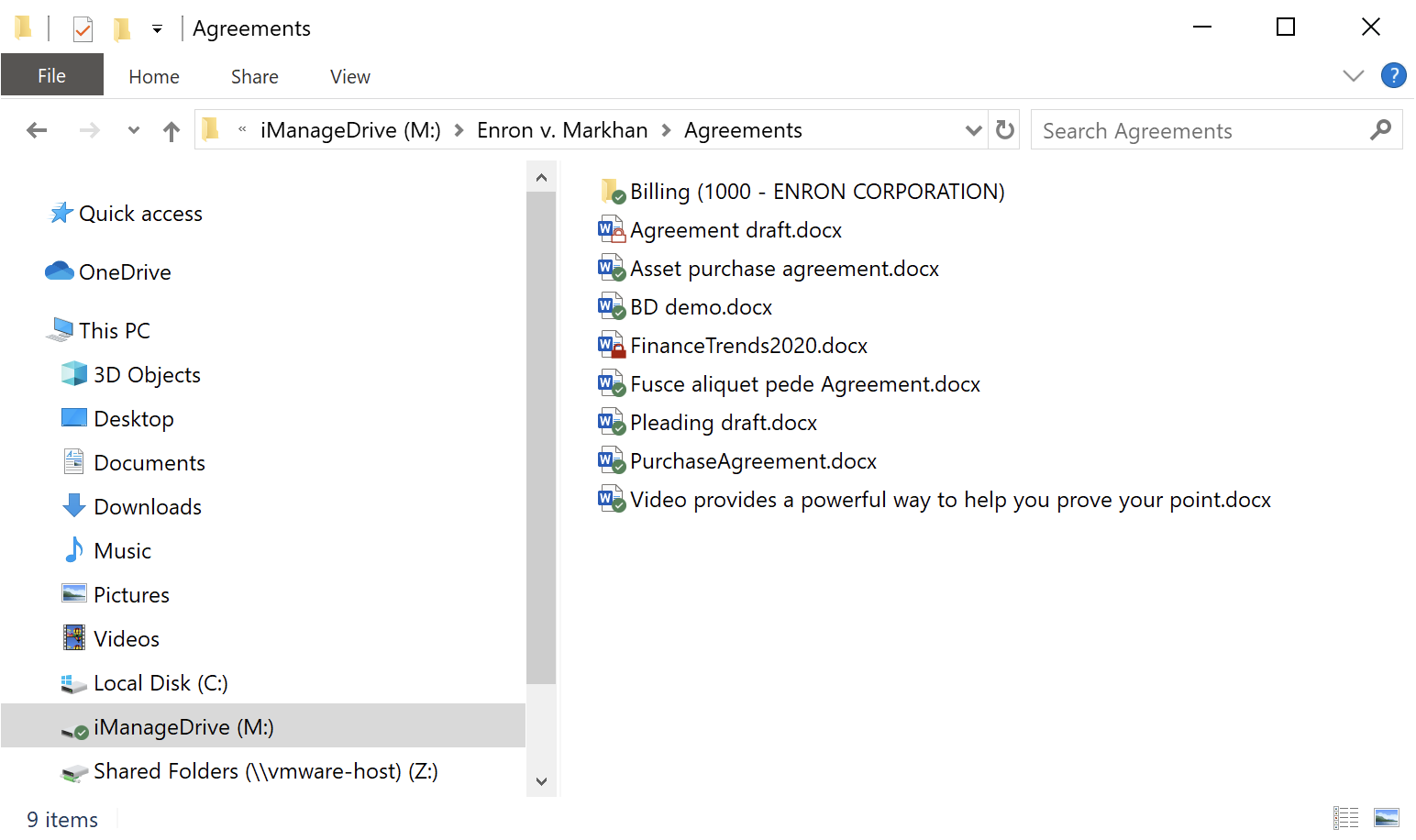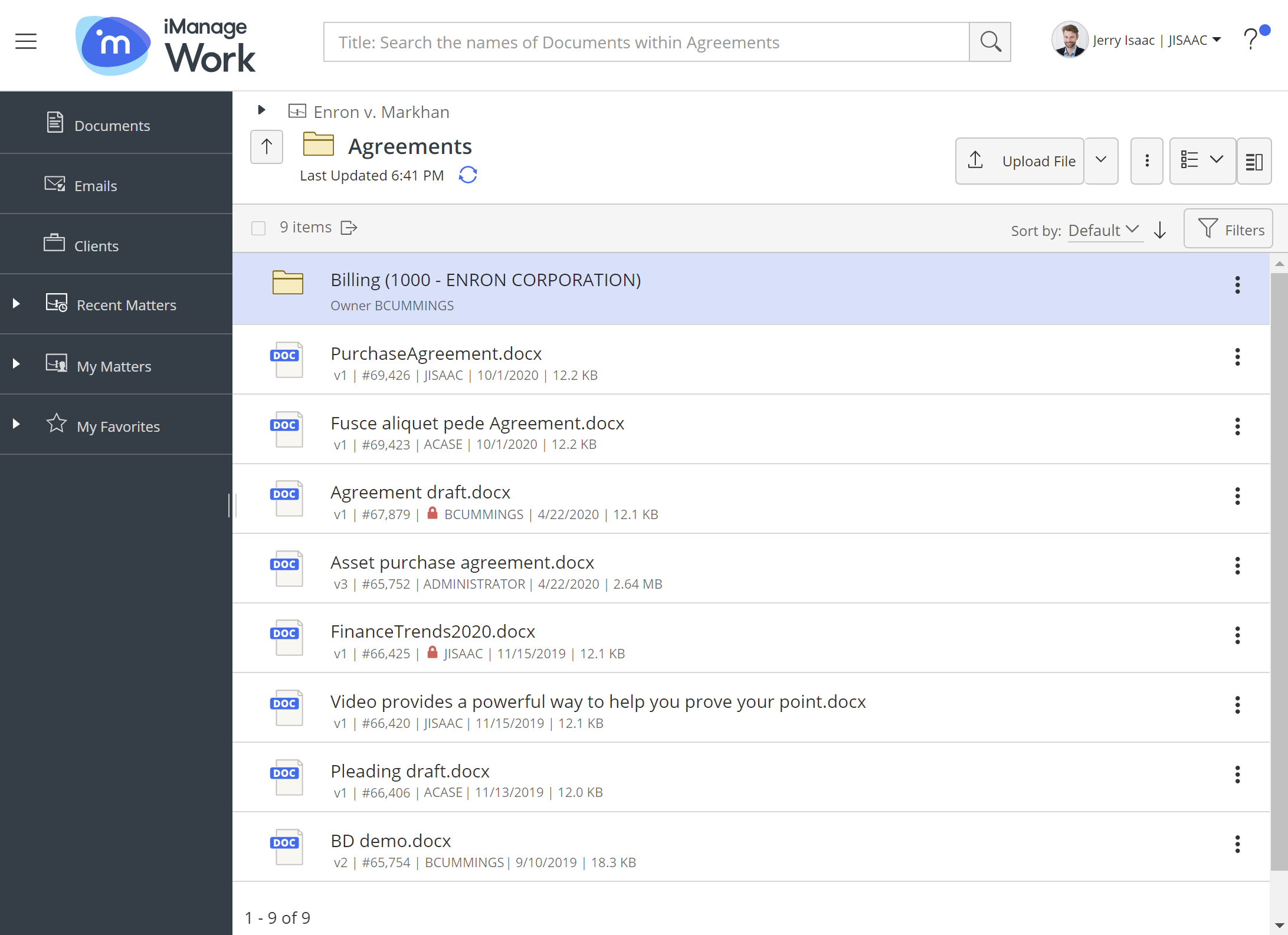Accessing iManage files using your local drive
While you run the iManage Drive setup wizard and the selected workspaces in iManage Work are synced to your local drive, select Open iManage Drive on the last screen to access the the mapped drive on your system and perform the file activities described in the Working with files in your local drive: Key use cases section. Alternatively, navigate to the mapped drive manually or select the Open iManage Drive Folder ![]() icon in the iManage Drive application.
icon in the iManage Drive application.
The following figure displays the mapped folder in the local drive (lower-left corner) and the contents within one of the workspaces (Matters) that was selected for syncing.
Figure: iManage content in a folder in the local drive

NOTE:
All folder content in the selected workspaces except search folders is synced to your local drive.
A cloud ![]() icon is displayed for workspaces, folders, and files to indicate that the content is available only in the online mode as only the metadata and not the actual files are synced to your local drive. Files in the folders are available in your local drive when you double-click to open them or right-click and select Download (always keep on this device). For more information, see Using the right-click menu options.
icon is displayed for workspaces, folders, and files to indicate that the content is available only in the online mode as only the metadata and not the actual files are synced to your local drive. Files in the folders are available in your local drive when you double-click to open them or right-click and select Download (always keep on this device). For more information, see Using the right-click menu options.
The ![]() icon is displayed for the My Matters and Recent Matters folders that are created in the mapped drive by default when you connect to an iManage Work Server. You can double-click any workspace with the
icon is displayed for the My Matters and Recent Matters folders that are created in the mapped drive by default when you connect to an iManage Work Server. You can double-click any workspace with the ![]() icon, and then double-click
icon, and then double-click ![]() when you need to work on the files in the workspace. For more information, see Accessing your My Matters and Recent Matters.
when you need to work on the files in the workspace. For more information, see Accessing your My Matters and Recent Matters.
Checked out files
The following overlay icons indicate files checked out by you or another user using iManage Work, iManage Drive, or any other iManage/integrated application:
 : Stub for checked-out file.
: Stub for checked-out file. : Checked out file downloaded to your mapped folder.
: Checked out file downloaded to your mapped folder.
The ![]() icon changes to
icon changes to ![]() when you select Download (always keep on this device) and changes again to
when you select Download (always keep on this device) and changes again to ![]() when you select Access online only. Though all checked-out files have either of the lock icons, the files checked out by other users open in Read Only mode and you can save them as a copy to the same folder or another location in your mapped drive and iManage Drive syncs them to iManage Work. This feature reduces the chances of conflicts arising in scenarios where two users edit a document simultaneously and when a document is already checked out by another user. For more information, see Conflict resolution.
when you select Access online only. Though all checked-out files have either of the lock icons, the files checked out by other users open in Read Only mode and you can save them as a copy to the same folder or another location in your mapped drive and iManage Drive syncs them to iManage Work. This feature reduces the chances of conflicts arising in scenarios where two users edit a document simultaneously and when a document is already checked out by another user. For more information, see Conflict resolution.
NOTE:
The Download (always keep on this device) option, when you right-click workspaces and folders, enables you to make content available in bulk for offline access. For more information, see Making content available for offline use.
Conflicts
The ![]() icon is displayed in your mapped folder for workspaces and files that are not getting synced or have a conflict. The following text describes scenarios where you will see this icon and provides information about how to resolve the sync issues:
icon is displayed in your mapped folder for workspaces and files that are not getting synced or have a conflict. The following text describes scenarios where you will see this icon and provides information about how to resolve the sync issues:
- Workspaces created in mapped folder and the content added to them: Creation of workspaces locally is not allowed. Any folder created in the iManage Drive root directory and the content users add to it does not get synced. Users must manually delete these folders.
- Files with conflicts: Users can resolve file conflicts using Notifications > Resolve Conflict. For more information, see Conflict resolution.
As you can see, the content within the workspaces in the local drive is identical to that in iManage Work.
Figure: Content in the folder in iManage Work

NOTE:
Only the latest version of the files in iManage Work is synced to your local drive. Hence, you can access and edit only the latest versions of these files.
If you add (paste, download, or drag) or modify the files in your local drive, the same changes are reflected in iManage Work. Similarly, changes that other users make to the files in iManage Work are mirrored in the files in your local drive.
If you rename a folder or file in your local drive, iManage Drive syncs the changes and the same are reflected in iManage Work.
Creation, deletion, and renaming of workspaces
- Workspaces can be created only in iManage Work and not in your local drive.
- Workspaces cannot be renamed from your local drive and an error message is displayed if you try to rename them.
- Deletion of workspaces and folders is not possible from your local drive. If you try to delete a workspace, an error message is displayed. A similar message is displayed if you try to delete folders when the Allow folder deletion option is disabled. To delete workspaces, use the iManage Work web client.
Offline behavior
- Only the files that you have downloaded are available offline in your local drive. If you select the Download (always keep on this device) option for a file while offline, the sync
 icon is displayed for file and it is downloaded when iManage Drive connects to internet the next time and syncs content. If you try to open a file that is not downloaded to your drive, an error message is displayed.
icon is displayed for file and it is downloaded when iManage Drive connects to internet the next time and syncs content. If you try to open a file that is not downloaded to your drive, an error message is displayed. - The application icon in the taskbar turns white
 indicating that internet is unavailable.
indicating that internet is unavailable.
Blocked workspace and folder actions
When the application blocks a delete, copy, create, rename or move action that is not allowed due to permission and other issues such as the option not being enabled, iManage Drive displays messages to communicate why the action was not allowed. This enables you to ensure that you do not repeat the same prohibited action, change settings as applicable to enable the action, or request the administrator for the required permissions.
Some of the scenarios where these messages appear are:
- Copying a folder outside iManage Drive when the
allow_folder_copy_outside_drivesetting is disabled. - Trying to move a folder outside iManage Drive.
- Renaming and deleting folders without the required level of permission to do so.
- Copying and moving folders to other folders without the required level of permission for the parent folders.
- Performing prohibited tasks such as trying to delete or move a folder when offline, moving folders across workspaces, and performing folder operations at the level where all workspaces are located, and in the My Matters and Recent Matters folders.
- Trying to delete folders when folder deletion is not enabled in the application Preferences.
Figure: Message for blocking folder deletion